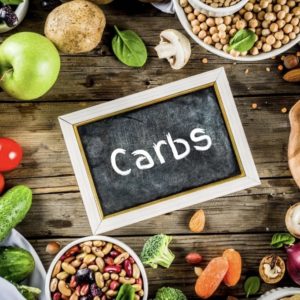In part 3 of my deep dive into the three macronutrients, it’s time to talk about the final macronutrient: Fat
Check out these posts to learn about the other two macronutrients: Protein + Carbs
Fat has been the “villain” of the nutrition family for years, undeservedly so in many cases. But before we get to why fats can actually be nutrition heroes, here are some basic facts about fats:
- Fats are made up of fatty acids.
- Fats are essential for proper nutrition and healthy living.
- Some fats are better than others.
- A lot of different foods contain fat.
There are basically two kinds of fats: Saturated and unsaturated.
Saturated Fats
Saturated fats are the more “solid” fats, and they can be found in foods like butter, shortening, cream, fatty meats, and full fat cheese, ice cream, yogurt, and milk as well as in oils that are solid at room temperature (coconut, palm, etc.). You can also often find saturated fats in baked goods and fried foods.
Saturated fats can raise your LDL (“bad”) cholesterol levels, which increases your risk for stroke, heart attack, and other health problems.
When it comes to eating saturated fat, the American Heart Association recommends keeping your consumption of these types of fats to 5-6% of your daily calories.
Unsaturated Fats
Unsaturated fats are the “healthy” fats, and they include both monounsaturated fats and polyunsaturated fats. Here are some sources for each:
- Monounsaturated fats: Oils (peanut, canola, olive, safflower, sunflower), avocados, most nuts and nut butters, and pumpkin and sesame seeds.
- Polyunsaturated fats: Oils (cottonseed, sunflower, soybean, corn), seeds (sesame, pumpkin, sunflower), walnuts, flaxseed, and pine nuts. Those healthy Omega-3 fats found in sardines, salmon, and herring are part of the polyunsaturated group too.
Unsaturated fats—the “healthy” fats—can lower your LDL cholesterol levels as well as the other benefits shared below.
With polyunsaturated fats, the American Heart Association recommends between 8-10% of daily calories come from these types of fats, and there is some research showing that increasing that number to 15% can actually lower your risk of heart disease.
Trans Fats
While not technically included in the fat categories, trans fats are definitely something to be aware of. Trans fats are created by hydrogenating vegetable oils, which then increases their shelf life. However, trans fats can cause some issues health-wise:
- Cause inflammation, which has been linked to chronic conditions like diabetes, stroke, and heart disease.
- Raise LDL cholesterol levels and lower HDL (“good”) cholesterol levels.
- Mess with insulin resistance.
And while the use of trans fats has almost been eliminated, they can still be found in some products, so be sure and check the labels of the foods you’re eating like shortening, microwave popcorn, stick margarine, frozen pizza, fried foods, and so on. The thing to remember here is to skip the trans fats altogether whenever possible.
The Functions of Fat
While fat can be problematic depending on how much and which types you eat, fat does have some beneficial functions in our bodies:
- Serves as a source of energy
- Helps proteins function better
- Essential for blood clotting
- Helps control some basic parts of metabolism: Growth, reproduction, immune function, and others
- Helps absorb some vitamins and minerals
- Helps build cell membranes
- Helps our muscles move
- Two fatty acids, omega-3 and omega-6, help protect the skin, heart, pancreas, and joints, and it helps keep your mood more stable
- Helps your skin look nicer!
To learn more about omega-3 and omega-6 fatty acids, go here.
How much fat should we be eating each day?
While you should stick to 5-6% of total calories from saturated fats and 8-15% of total calories from unsaturated fats, the overall fat consumption guidelines are that a healthy diet should be between 20-35%, according to the 2015-2020 Dietary Guidelines for Americans.
When figuring out calories from fat, each gram of fat = 9 calories, which can pack a calorie punch if you’re not careful. Just as a reminder, each gram of protein and carb = 4 calories.
Healthy Fat Tips
Not sure how to include fat in your diet in a healthy way? Here are some helpful tips:
- Again…limit saturated fats and try and avoid trans fats altogether.
- Cook with healthy oils like olive oil and canola oil.
- Use nonfat cooking sprays whenever possible.
- Put avocado on sandwiches, salads, smoothies, guacamole, etc.
- Get a little bit nutty—emphasis being on a little bit. While nuts and nut butters are loaded with healthy fat, vitamins, and minerals, they do pack a calorie punch if you’re not careful, so keep an eye on the serving size.
Fat is not the villain it’s been portrayed to be. And while it can be easy to overdo it when enjoying those delicious foods that contain fat (#peanutbutterlover), when fat is included in a healthy way in your overall nutrition plan, it can provide many health benefits, making it a nutrition hero.
Have additional questions about fats or any other health and fitness topic? I’m always looking for new topics to write about, so please leave a comment below.
Disclaimer: The views, opinions, positions, research, analyses, strategies or other information discussed here are my views and are for informational purposes only. Please consult your physician or other health care professional before beginning this or any nutrition program or before incorporating any of this information into your health and wellness program.






Leave a Reply